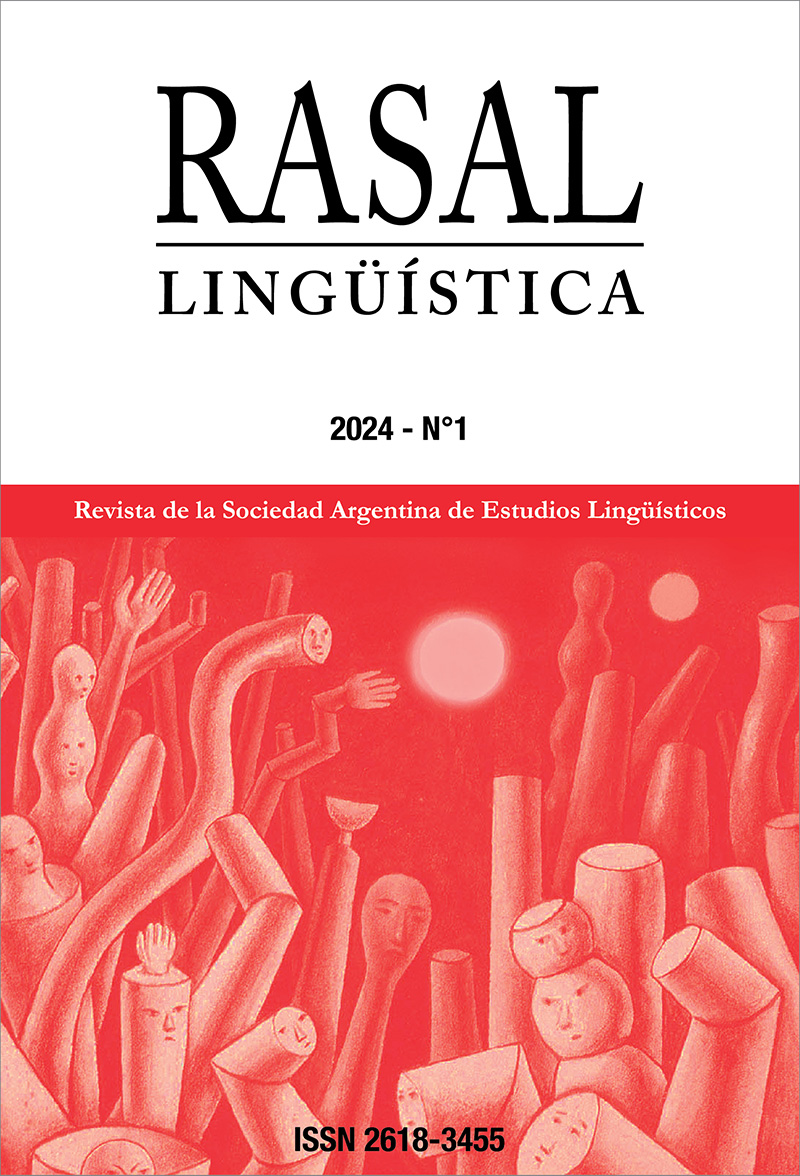Applicative construction in ayoreo (zamucoan): discoursive motivation
DOI:
https://doi.org/10.56683/rs241004Keywords:
low applicatives, obliques, topicworthiness, referential distance, topic persistenceAbstract
Applicatives are constructions that enable the expression of an oblique or thematically peripheral participant as part of the verb's core argument structure (Peterson, 2007). According to one functional explanation, their primary function is to signify that the entity being referred to has greater persistence and discursive prominence (cf. 'topic continuity' and 'topic persistence,' as proposed by Givón, 1983; Rude, 1985; Peterson, 2007).
Ayoreo exhibits characteristics of a fusional language with traits of a dependent-marking system. It demonstrates an emerging category of applicatives through the cliticization of multifunctional adpositions such as iji, aja, and ome to the verbal base. This phenomenon coexists with the use of adpositional phrases to represent oblique arguments.
Our objective is to elucidate the discursive motivation of applicatives in Ayoreo, based on a textual corpus that encompasses various genres. Non-subject argument-marking strategies are categorized into three types: canonical marking (expressed through nominal phrases), oblique marking (utilizing adpositional phrases), and applied marking (accomplished through verb cliticization).
The results indicate that applied constructions exhibit higher topic persistence and lower referential distance compared to oblique participants. In other words, they maintain a high level of topicality across discourse sequences, despite being activated in the minds of the speaker or the hearer, given their recent mention.
Downloads
References
Bertinetto, P. M. (2009). Ayoreo (Zamuco). A grammatical sketch. Quaderni del Laboratorio Linguistica.
Carol J. (2011). Aplicativos/adposiciones en chorote (mataguayo): algunos aspectos formales. LIAMES 11, 51—74.
Carol, J. (2019). Adposiciones en chorote-manjui: entre adposiciones, aplicativos y clasificadores verbales. En L. Guerrero (Ed.), Adposiciones y elementos de su tipo en lenguas de América (pp. 87-146). Universidad Nacional Autónoma de México.
CEDIB. (9 de agosto de 2013). Indígenas ¿Quién gana, quién pierde?. http://cedib.org/tag/censo-2012/
Censabella, M. y Terraza, J. (2009). Aplicativos en toba y wichí; forma y función. II Encuentro de Lenguas Indígenas Americanas y II Simposio Internacional de Lingüística Amerindia (ALFAL).
Comrie, B. (2013). Alignment of Case Marking of Full Noun Phrases. En: Dryer, Matthew S. & Haspelmath, Martin (eds.) WALS Online (v2020.3) [Conjunto de datos]. Zenodo. https://doi.org/10.5281/zenodo.7385533
DGEEC. (2012). DGEEC: Dirección General de Estadística, Encuestas y Censos. https://www.ine.gov.py/vt/publicacion.php
Durante, S.. (2016). Documentation and description of Paraguayan Ayoreo. ELAR Archive. https://www.elararchive.org/uncategorized/SO_665634c2-ca34-47c5-a9f3-4f63015e78f4/#items
Durante, S. (2021). Cláusulas adverbiales en ayoreo (zamuco). Estrategias de inclusión clausal en una lengua con tendencia paratáctica. Forma y Función, 34(2), 135—164.
Etacore, B. y Durante, S. (eds). (2018). Campo Loro gosode oe ojñane udojo - Historias de los pobladores de Campo Loro. FILO: UBA.
Fernández Garay, A. (2012). Lingüística areal: las construcciones aplicativas en algunas lenguas patagónicas. Anuario de la Facultad de Ciencias Humanas. Año X. Volumen 10. N° 1.
Givón, T. (1983). ‘Topic Continuity in Discourse: An Introduction’. En T. Givón (Ed.), Topic Continuity in Discourse: A Quantitative Cross-Language Study (pp. 1–41). John Benjamins.
Haspelmath, M. (2013). Ditransitive Constructions: The Verb 'Give'. In: Dryer, M. S. y Haspelmath, M. (eds.) WALS Online (v2020.3) [Conjunto de datos]. Zenodo. https://doi.org/10.5281/zenodo.7385533
Hopper, P. .(1991) ‘On some principles of grammaticization’. En J., E. C. Traugott y B. Heine (eds). Typological Studies in Languages 19 (pp. 12–22). John Benjamins.
Lehmann, Ch. (2017). Reference: Basic concepts. http://www.christianlehmann.eu/presentations/refer/basic_concepts/index.html
Peterson, D. A. (2007). Applicative Constructions. Oxford: Oxford University Press.
Rude, N. (1985). Studies in Nez Perce Grammar and Discourse. [Tesis doctoral, University of Oregon].
Tacconi, T; Messineo, C. (2019). Construcciones aplicativas en maká: Morfosintaxis y semántica. En L. Guerrero (Ed.), Adposiciones y elementos de su tipo en lenguas de América (pp. 51-86). Universidad Nacional Autónoma de México.
Thompson, S. (1990). Information flow and dative shift in English Discourse. En: Edmonson, Crawford y Mulhausler (eds). Devolopment an Diversity. Language variation across time and space. Austin: Summer Institute of Linguistics and the University of Texas at Arlington.
Vidal, A. (2001). Pilagá Grammar. PhD Dissertation. University of Oregon.
Vidal, A y Nercesian, V. (2006). Construcciones aplicativas en wichí. 52 Congreso Internacional de Americanistas (Manuscrito inédito.)
Van Valin, R. (2005 [2003]). Exploring the Syntax-Semantics Interface. Cambridge: Cambridge University Press.
Zanardini. J. (1994). Beyori ga yicatecacori. Ayoreo - Español. Asunción: Editorial Don Bosco.
Published
How to Cite
Issue
Section
License
Copyright (c) 2024 Santiago Durante

This work is licensed under a Creative Commons Attribution-NonCommercial 4.0 International License.
RASAL © Algunos derechos reservados










